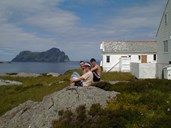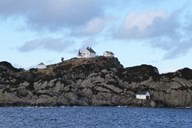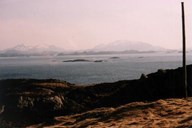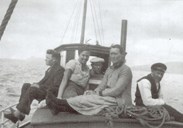Built in 1897
The Geita lighthouse was built in 1897 and on 6 October the same year the lantern was switched on for the very first time. As early as in 1891, there was a lighthouse on the island of Raudøy a little further to the northeast, at the entrance to the Vilnesfjord.
The first lantern in the Geita lighthouse was a petroleum lamp with three wicks, one outside the other, in order to get a sufficiently strong beacon.
The first lighthouse keeper was Hans Christian Andersen (1842-1903) from Halden, married to Hilma Caroline Terese, born 1845 in Stockholm. Andersen died in April, 1803, and his son (with the same name) stepped in until a new keeper was employed in November the same year.
Ingvar Wetlesen then took over the work as lighthouse keeper, holding this position for almost 25 years until September, 1928. In 1931, during the period of service of the third keeper, Martin Hjalmar Rønning, the old petroleum lamp was replaced by an incandescent burner which functioned almost like a gigantic Primus lamp. This meant that the light was now stronger and more stable. The beacon now had a luminous intensity with a range of 18 nautical miles.
The shift system
Up until the time Rønningen retired as keeper in July, 1939, the lighthouse was staffed with one keeper and his family. Afterwards the staff was extended with one assistant for six months of the year.
Wherever possible, some farming took place on the lighthouse grounds, and this was also the case on the island of Geita. They had cows and sheep, and did their best to get something to grow in the barren soil.
As of 1957, the Geita lighthouse became a shift station with a lighthouse master, lighthouse assistant, and an extra person working nine months. The families were moved ashore, thus making the island an all-male community. The shift system meant that people worked for four weeks in a row with two weeks off afterwards.
On 9 July, electricity was installed with a 500 W lamp. The lighthouse was changed from permanent light to occulting light with periods of five seconds of light and one second of dark. There were two generators, each of 4.5 kW. Electricity was also installed in the keeper's residence, the machine building, and the boathouse, as well as outside, which made it easier to find one's way between the houses in darkness.
Communication equipment
In November, 1970, the lighthouse station got VHF connection with Florø Radio. This communication system was a marked improvement compared with the old radio telephone the station had had since 1956. The radio telephone had regular listening hours at 9.30, noon, and 18.00. Everybody could listen in on the fisheries wavelength, whereas the new system was closed. In February, 1978, the station got ordinary telephone communication.
Automated
In the period between 1942 and 1967, no less than 29 ships ran aground in the vicinity of Geita. Three of these were total wrecks, whereas the others could be rescued. The crew onboard the ships that were totally wrecked were able to get ashore on Geita and were taken care of by the lighthouse staff.
In the morning hours of 6 October, 1997, the lighthouse was struck by lightning, which meant that the lighthouse was out of operation. Much of the electrical installation was destroyed, and the VHF communication fell out. Fortunately, none of the staff suffered any injuries.
Olav Oddekalv was the last lighthouse keeper on the island of Geita. He took over the position in 1979, but the following year the lighthouse was automated. From 1982, there have been no permanent residents at the lighthouse station.
At present there is no lighthouse keeper making his regular rounds day and night to check that everything is working. Everything is automated.
Listed holiday residence
In 1999, the lighthouse was listed by the Directorate for Cultural Heritage. In addition to the lighthouse itself, this also includes the residence and all other buildings and grounds on the island where the lighthouse is located. The assistant's residence was torn down in the 1960s.
Today it is possible for holiday-makers to get accommodation on the island. The main building can be rented, and this may also include a caretaker or a boatman. It is also possible to fish from the island itself, or go out in a boat. Another activity is diving. From the island there is a fine view in all directions, towards the open sea, to the surrounding archipelago or to the mainland.
The mermaid from Geita
In the early hours of 8 July, 1933, the lighthouse keeper's wife, Agnes Rønning, found an unknown woman asleep on a stack of hay. At first she thought this was a vagrant who had passed the night there, but this turned out to be wrong. The woman was exhausted, she was bruised all over her body, and her dress was torn to shreds. She did not understand Norwegian, but Mrs Rønning was able to establish contact with the woman in English. Mrs Rønning understood that the woman had come by boat. She had evidently jumped overboard from a German cruise liner and swam ashore on the island of Geita.
The two sons in the family rowed in to Askvoll to report the incidence to the police authorities. The police then informed them that the woman came from Brno in Czechoslovakia and her name was Grete Wittrich. In a state of anger and influenced by alcohol she had jumped overboard. She had swum from one small island to another before she ended up on the island of Geita. It is quite incredible that she had survived such a long swim.
Grete Wittrich was given a residence permit for two months in Norway. Throughout this time she stayed on the islands of Geita and Aralden, where she took part in various chores in the household and on the farm. In late July, there was an annual service at the stone cross at Korssund on the Sunday closest to the St. Olaf's Day, and this summer many people travelled long distances to Korssund just to get a glimpse of the "Mermaid from Geita".
Later that summer some family members came to the island to take her back to Czechoslovakia.





